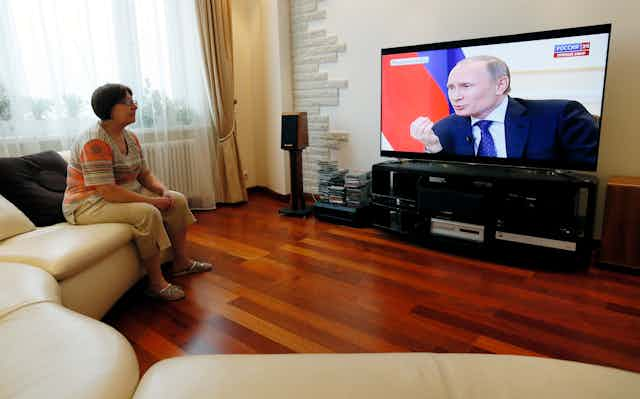So far, thankfully, the peace has held in Crimea. But an information war is already raging in the region. Misinformation; doubtful sources; news published; then corrected – then the correction is corrected; “personal” hysterical stories from all sides; rumours; propaganda; social media hype. We have witnessed it all in recent days and weeks in coverage of events in Ukraine.
In the words of Jean Baudrillard:
News is producing the ‘reality’ of the war, not only for viewers, but also for those involved. Propaganda is thereby taken to a new level: it isn’t a case of misrepresenting what is actually happening somewhere in a different way; more a case of constructing what will be happening in advance (that is, what will be happening to the troops on the other side of the conflict), so that it does happen.
But in a way, media coverage of events in Ukraine has overcome the thoughts of the famous French philisopher. The protests and conflicts in Ukraine have, of course, not only been happening on television – they are also online, and on social media. They’ve been commented on, reposted and retweeted. In mid-February, while the fights on Maidan were at their height, a Kommersant correspondent in Kiev, Ilya Barabanov, wrote on his Facebook wall: “The fights are about to start in about two hours – just at the time when you, Moscow-based viewers, will finish watching Russia-US hockey match.”
In Russia, opinions on media and social media are split on the Ukrainian matter. While a larger group of independent (liberal) print and online media follows an anti-war and pro-Maidan discourse (though the two don’t necessarily always come as a pair), almost all television and state-controlled media coverage keeps up a different agenda, which, however, also changes. In the early days of Maidan, the protesters on the streets of Kiev were univocally described as “financed from the West, provocateurs, hooligans and extremists”. Now Vladimir Putin suggests a broader perception of the issue, bringing in economic and social factors, including “banditism, nepotism and clanism, first of all, in the economy – people see it all and that brings in lack of trust for the authorities”.
TV gets it wrong
The degree of “official media support” for Viktor Yanukovych has also gone significantly down after his loss and exile to Russia. Yet, state Russian television picked up a new topic – nationalistic (and even “fascist”, a very strong and often misused word in Russia) forces in Ukraine threatening Russian minorities. There have been a few remarkable faux pas on television, including video coverage from the Ukrainian-Polish border with large groups of Ukrainians leaving the country, which was shown as the Ukrainian-Russian border and commented upon as “Ukrainians fleeing chaos to Russia”.
In general, the degree of hysteria has been on the rise in all media and social networks. The latter have been filled with “personal reports” of friends, relatives etc – ranging from horror tales of “secret massacres” to conspiracy theories. There were also the reports of Yanukovych’s death and a plot to murder a few Russian soldiers in order to allow the Russian forces to start using weapons. With so many national groups in Crimea – Tatars, Jews, Ukrainians, Russians –- with most people being a mixture of a few, public appeals from various national, regional and political groups also come in abundance.
Enter the bloggers
It is not that there are no nationalistic forces in Ukraine. But with one side turning them into absolute villains and another side claiming there is no nationalism in Ukraine whatsoever, it can be tricky to establish the truth. A few media outlets, such as Lenta.ru and Kommersant have tried to provide balanced reporting from the on-site journalists. Some leftist media (rabkor.ru, openleft.ru) have also taken a more neutral approach, criticising pretty much everyone, including Russia, the EU and the US. They have also looked at issues of social and economic justice, and political independence from any “big players”.
A few famous Russian bloggers have also made their way to Kiev and Crimea in order to report developments. Ilya Varlamov described a rather “calm, but nervous” situation in Simferopol, with people being more twitchy about propaganda, than soldiers on the streets. “Up till now propaganda from both sides ‘kills’ more people than a possible war – people are really going crazy from all this news on television and Internet,” Varlamov claimed. He then went into a very detailed description about unidentified, very polite, well-dressed and equipped, but silent soldiers, on the streets of the city next to military equipment with no identification marks – “everyone thinks they’re Russian”, even though officially Russia claims that forces are part of a Crimean self-defence service.
Making your mind up
And then there are the analyses, rumour, propaganda and eye-witness reports on social networks and Twitter. In a situation with too much information around, we still can’t make up our minds, can’t get to the truth, can’t decide who’s the good guy and the bad guy – often it’s really impossible to say.
But traditional storylined news narratives lose out – because in such a complicated situation, when quite often there’s not one good and one bad side, it’s impossible to write down a linear story. But, rather, the story will be a) very long, b) multi-layered, c) with no obvious conclusions, and d) will contain multiple conflicting interests. In other words, the only solution is to read as much in as many languages as possible – and make up your own mind, while being prepared to change it drastically tomorrow.

